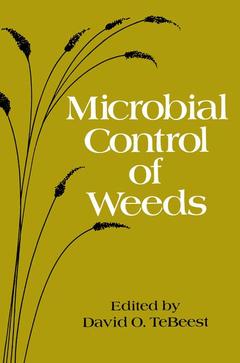Description
Microbial Control of Weeds, Softcover reprint of the original 1st ed. 1991
Coordinator: TeBeest D.O.
Language: English
Subjects for Microbial Control of Weeds:
Keywords
Pathogen; agriculture; cell; ecology; epidemiology; pesticide; pesticides; plant; soil
Publication date: 02-2012
284 p. · 15.2x22.9 cm · Paperback
284 p. · 15.2x22.9 cm · Paperback
Description
/li>Contents
/li>
It is appropriate at this time to reflect on two decades of research in biological control of weeds with fungal plant pathogens. Some remarkable events have occurred in the last 20 years that represent a flurry of activity far beyond what could reasonably have been predicted. In 1969 a special topics review article by C. L. Wilson was published in Annual Reviews of Phytopathology that examined the literature and the potential for biological control of weeds with plant pathogens. In that same year, experiments were conducted in Arkansas that determined whether a fungal plant pathogen could reduce the infestation of a single weed species in rice fields. In Florida a project was under way to determine the potential use of a soil-borne plant pathogen as a means for controlling a single weed species in citrus groves. Work in Australia was published that described experiments that sought to determine whether a pathogen could safely and deliberately be imported and released into a country to control a weed of agricultural importance. All three projects were successful in the sense that Puccinia chondrillina was released into Australia to control rush skeleton weed and was released later into the United States as well, and that Colletotrichum gloeosporioides f.sp. aeschynomene and Phytophthora palmivora were later both marketed for the specific purpose of controlling specific weed species.
Biological Control of Weeds.- 1. The Classical Approach with Plant Pathogens.- 2. The Mycoherbicide Approach with Plant Pathogens.- 3. Nematodes as Biological Control Agents of Weeds.- 4. Options with Plant Pathogens Intended for Classical Control of Range and Pasture Weeds.- Host-Parasite Interactions.- 5. Host-Range Testing: Safety and Science.- 6. Ecology and Epidemiology of Fungal Plant Pathogens Studied as Biological Control Agents of Weeds.- 7. Parasitism, Host Species Specificity, and Gene-Specific Host Cell Death.- Genetic Manipulation of Plant Pathogens.- 8. Perspectives for Biological Engineering of Prokaryotes for Biological Control of Weeds.- 9. Genetic Manipulation of Plant Pathogenic Fungi.- 10. Protoplast Fusion for the Production of Superior Biocontrol Fungi.- Application Technology.- 11. Integration of Biological Control Agents with Chemical Pesticides.- 12. Progress in the Production, Formulation, and Application of Mycoherbicides.- Economic Aspects of Biological Control.- 13. Submerged Fermentation of Biological Herbicides.- 14. Economic Aspects of Biological Weed Control with Plant Pathogens.- Summary.- Contributors.
© 2024 LAVOISIER S.A.S.
These books may interest you

Atlas of Weed Mapping 247.51 €



